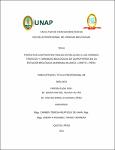| dc.contributor.advisor | Reátegui de Kahn, Carmen Teresa | |
| dc.contributor.advisor | Tirado Herrera, Emérita Rosabel | |
| dc.contributor.author | Del Aguila Alván, Edson Raí | |
| dc.contributor.author | Godos López, Cinthia Mirella | |
| dc.date.accessioned | 2021-07-12T11:21:19Z | |
| dc.date.available | 2021-07-12T11:21:19Z | |
| dc.date.issued | 2021 | |
| dc.identifier.uri | https://hdl.handle.net/20.500.12737/7336 | |
| dc.description.abstract | La presente investigación tuvo como objetivo estudiar los parásitos gastrointestinales en relación a los gremios tróficos y variables biológicas de quirópteros. Se analizaron 74 quirópteros en la Estación Biológica Quebrada Blanco en el distrito de Fernando Lores, departamento de Loreto. Los animales fueron capturados, agrupados en gremios tróficos, se sacrificaron con el fin de extraer los parásitos de los tractos digestivos, que se identificaron a nivel de género y especie, se calcularon índices parasitarios y variables biológicas de los quirópteros. Se describió un total de 15 parásitos, de los cuales 10 fueron nematodos, 4 trematodos y un cestodo. La prevalencia general de infección fue de 36.5%. Del total de helmintos encontrados el 83.8% correspondió a Ochoterenatrema, Anenterotrema liliputianum, Neodiplostomum vaucheri y Metadelphis compactum, el 11.8% correspondió a los nematodos Aoncotheca, Cheiropteronema, Physaloptera, Seuratum, Allintoshius parallintoshius, Biacantha desmoda, Cheiropteronema striatum, Histiostrongylus coronatus, Parahistiostrongylus octacanthus y Tricholeiperia leiperi y el cestodo Vampirolepis. El gremio trófico carnívoro/insectívoro presentó mayor prevalencia (50%), abundancia y riqueza. En cuanto a las relaciones entre los índices parasitarios y las variables biológicas, respecto al sexo los machos presentaron mayores tasas de prevalencia (42.5%), riqueza y abundancia. A pesar de estos resultados, no existió una relación entre estas dos variables. Por otra parte, de acuerdo a la prueba de correlación, el peso y la longitud de los quirópteros no estuvieron influenciados por la abundancia de los parásitos, excepto en Garnerycteris crenulatu. En conclusión, los parásitos gastrointestinales no están relacionados a los gremios tróficos y variables biológicas de los quirópteros de la Estación Biológica Quebrada Blanco. | es_PE |
| dc.description.abstract | The present investigation aimed to study gastrointestinal parasites in relation to trophic guilds and biological variables of Chiropterans. 74 chiropterans were analyzed at the Quebrada Blanco Biological Station in the Fernando Lores district, Loreto department. The animals were captured, grouped in trophic guilds and sacrificed in order to extract the parasites of their digestive tracts, which were identified at the genus and species level, parasitic indices and biological variables of the chiropterans were calculated. A total of 15 parasites were described, of which 10 were nematodes, 4 trematodes and one cestode. The general prevalence of infection was 36.5%. Of the total number of helminths found, 83.8% corresponded to Ochoterenatrema, Anenterotrema liliputianium, Neodiplostomum vaucheri and Metadelphis compactum, 11.8% corresponded to the nematodes Aoncotheca, Cheiropteronema, Physaloptera, Seuratum, Allintoshius parallintoshius, Biacantha desmoda, Cheiropteronema striatum, Histiostrongylus coronatus, Parahistiostrongylus octacanthus and Tricholeiperia leiperi and the Vampirolepis cestode. The insectivorous trophic guild presented higher prevalence (50%), abundance and richness. Regarding the relationships between the parasitic indices and the biological variables, regarding sex, the males presented higher prevalence rates (42.5%), richness and abundance. Despite these results, there was no relationship between these two variables. On the other hand, according to the correlation test, the weight and length of the chiropterans were not influenced by the abundance of the parasites, except for Garnerycteris crenulatum. In conclusion, the gastrointestinal parasites are not related to the trophic guilds and biological variables of the chiropterans of the Quebrada Blanco Biological Station. | es_PE |
| dc.format | application/pdf | es_PE |
| dc.language.iso | spa | es_PE |
| dc.publisher | Universidad Nacional de la Amazonía Peruana | es_PE |
| dc.rights | info:eu-repo/semantics/openAccess | es_PE |
| dc.rights.uri | https://creativecommons.org/licenses/by/4.0/ | es_PE |
| dc.subject | Parásitos intestinales | es_PE |
| dc.subject | Niveles tróficos | es_PE |
| dc.subject | Murciélago | es_PE |
| dc.subject | Chiroptera | es_PE |
| dc.subject | Estaciones climáticas | es_PE |
| dc.title | Parásitos gastrointestinales en relación a los gremios tróficos y variables biológicas de quirópteros en la estación biológica Quebrada Blanco, Loreto – Perú. | es_PE |
| dc.type | info:eu-repo/semantics/bachelorThesis | es_PE |
| thesis.degree.discipline | Ciencias Biológicas | es_PE |
| thesis.degree.grantor | Universidad Nacional de la Amazonía Peruana. Facultad de Ciencias Biológicas | es_PE |
| thesis.degree.name | Biólogo | es_PE |
| dc.subject.ocde | http://purl.org/pe-repo/ocde/ford#1.06.01 | es_PE |
| renati.author.dni | 74455942 | |
| renati.author.dni | 73890002 | |
| renati.advisor.orcid | https://orcid.org/0000-0001-5636-2359 | es_PE |
| renati.advisor.orcid | https://orcid.org/0000-0001-6459-5666 | es_PE |
| renati.advisor.dni | 05267255 | |
| renati.advisor.dni | 05268583 | |
| renati.type | http://purl.org/pe-repo/renati/type#tesis | es_PE |
| renati.discipline | 511206 | es_PE |
| renati.level | http://purl.org/pe-repo/renati/level#tituloProfesional | es_PE |
| renati.juror | Cachique Pinche, Mirle | |
| renati.juror | Pezo Lozano, Etersit | |
| renati.juror | Bendayan de Pezo, Nora Yonny | |
| dc.publisher.country | PE | es_PE |


